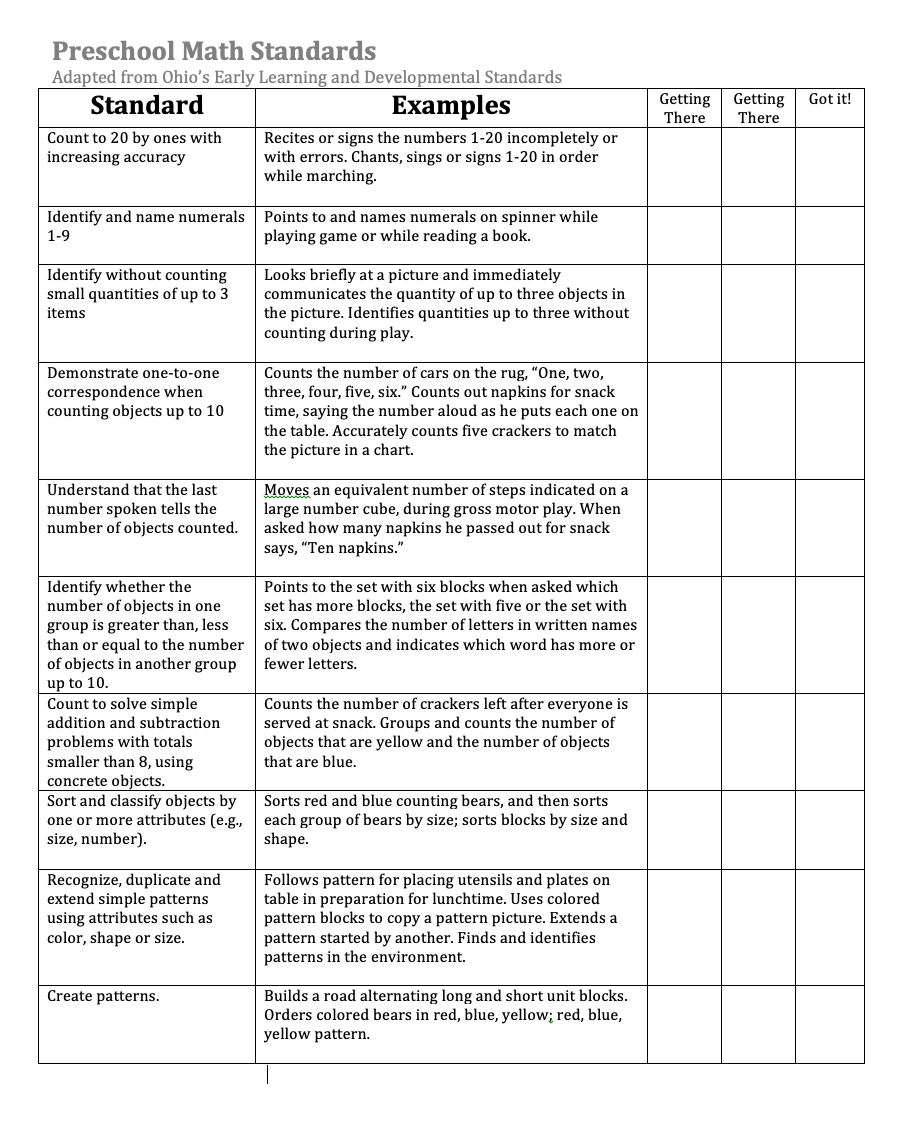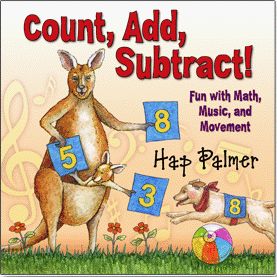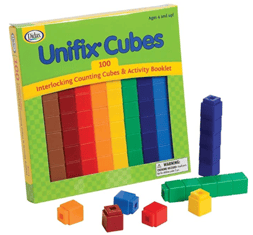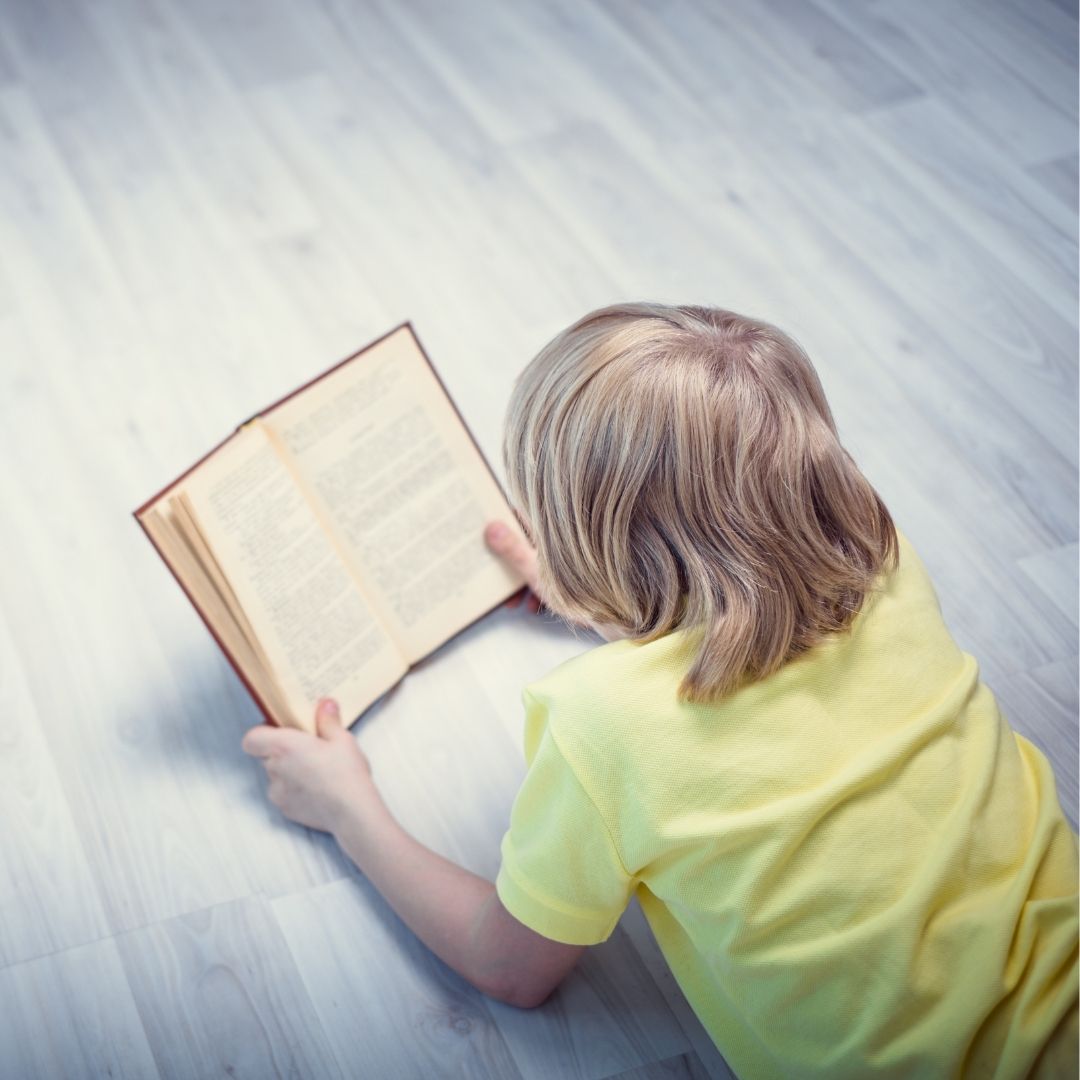When it comes to preschoolers and math, counting numbers is likely the first thing that comes to mind. Learning to count is typically the first obvious "math" skill that children pick up in their earliest years. But as babies and toddlers become preschoolers and move closer and closer to Kindergarten, there are a number of additional "math" skills that they must acquire as a foundation for their formal education.
Nineteen, actually. That's the number of math-focused skills that Ohio's Department of Education outlines in its Early Learning and Development Standards for kids aged 3-5 years old. Ohio's ELDS are a 57-page document with educational expectations for ages birth through five years of age. Most of the math-centric standards, though, are targeted at the older end of that range. These standards are followed across the state by early learning centers, and most preschool and early learning curriculums are based on them.
For any preschool parent that may be wondering, "What math skills should I be working on with my child?" or "Which math skills are most important to prepare my preschooler for Kindergarten?", a 57-page document geared towards professional educators may feel overwhelming. Arguably the most important math skills that preschoolers need to practice can be summed up as:
- Number Sense (counting to 20, 1:1 correspondence up to 10, beginning concept of more or less)
- Patterns (ABAB, ABC, understanding that patterns repeat)
- Number Recognition (0-10)
- Number Writing (1-10)
- Sorting and Matching (concepts of same and different)
- Shape Recognition
These skills can be woven into everyday life, conversation, and play. Counting (and even basic addition and subtraction) can be done with the buttons on a shirt, the cars you see in a parking lot, items in a picture book, food eaten at snacks and meals, etc. There are many free printables to help preschoolers practice writing numbers like this one or these. Memory and matching games are also excellent ways to instill the brain muscles needed for success in math (and practice turn-taking!).
For any parent interested in digging a little deeper into specific more specific math skills for preschoolers, here is a simple breakdown of each skill listed by Ohio's ELDS, examples of the skill in use, and ideas for how to incorporate these skills into home life. [The following standards and examples are adapted from Ohio's ELDS; the full 57-page document can be found here.]
Math Standards for Preschoolers
1. Count to 20 by ones with increasing accuracy.
- Examples: Recites or signs the numbers 1-20 incompletely or with errors. Chants, sings or signs 1-20 in order while marching.
2. Identify and name numerals 1-9.
- Examples: Points to numerals in a book as they are pointed out. Points to and names numerals on spinner while playing game.
3. Identify without counting small quantities of up to 3 items.
- Examples: Looks briefly at a picture and immediately communicates the quantity of up to three objects in the picture. Identifies quantities up to three without counting during play and daily routines (e.g., sorting bears, getting snack, etc.).
4. Demonstrate one-to-one correspondence when counting objects up to 10.
- Examples: Counts the number of cars on the rug, “One, two, three, four, five, six.” Counts out napkins for snack time, saying the number aloud as he puts each one on the table. Accurately counts five crackers to match the picture in a chart.
5. Understand that the last number spoken tells the number of objects counted.
- Examples: Moves an equivalent number of steps indicated on a large number cube, during gross motor play. When asked how many napkins he passed out for snack says, “Ten napkins.”
6. Identify whether the number of objects in one group is greater than, less than or equal to the number of objects in another group up to 10.
- Examples: Points to the set with six blocks when asked which set has more blocks, the set with five or the set with six. Compares the number of letters in written names of two objects and indicates which word has more or fewer letters. Responds to questions like, “Does Jason have as many crackers as Jasmine?”
7. Count to solve simple addition and subtraction problems with totals smaller than 8, using concrete objects.
- Examples: Counts the number of people present and then finds out how many children are there altogether. Responds appropriately when asked, “Right now there are five people at our snack table. How many people will be here if Grandma comes?”
- Groups and counts the number of objects that are yellow and the number of objects that are blue.
8. Sort and classify objects by one or more attributes (e.g., size, number).
- Examples: Sorts red and blue counting bears, and then sorts each group of bears by size. Sorts blocks by size and shape for storing on shelf at clean-up time.
9. Recognize, duplicate and extend simple patterns using attributes such as color, shape or size.
- Examples: Follows pattern for placing utensils and plates on table in preparation for dinnertime. Uses colored pattern blocks to copy a pattern picture. Extends a pattern started by another. Finds and identifies patterns in the environment.
10. Create patterns.
- Examples: Builds a road alternating long and short unit blocks. Orders colored bears in red, blue, yellow; red, blue, yellow pattern.
11. Describe and compare objects using measurable attributes (e.g., length, size, capacity and weight).
- Examples: Compares shoe sizes to see who has the bigger or smaller shoe. Sorts and classifies objects and can explain the sorting criteria (e.g., one rock is heavier than the other; one pencil is longer, etc.).
12. Order objects by measurable attribute (e.g., biggest to smallest, etc.).
- Examples: Places the different sized plates from biggest to smallest on the table. Orders blocks by height, tallest to shortest while building his “town” in the block area.
13. Measure length and volume (capacity) using non-standard or standard measurement tools.
- Examples: Measures how many paper clips it takes to be as long as a pencil. Measures how many small containers it takes to fill one large container at the sand table.
14. Demonstrate understanding of the relative position of objects using terms such as in/on/under, up/down, inside/outside, above/ below, beside/between, in front of/ behind and next to.
- Examples: Communicates, “My toy fell under the table,” or “I left my ball outside,” or “Sit down beside me.” Navigates an obstacle course when the teacher says, “Go under the bridge, and then go around the climber.” Says, “My dad keeps the car inside the garage.” Builds simple but meaningful “maps” using blocks and toys such as trees, cars, houses, and describes relative positions. (e.g., “The truck is beside the road.” “The dog is behind the house.”).
15. Understand and use names of shapes when identifying objects.
- Examples: Points and names the circle, square, rectangle and triangle shapes while working with puzzles. Identifies different shapes that are called out loud, while playing a game of shape bingo. Asks a friend, “Can I have another square block?”
16. Name three-dimensional objects using informal, descriptive vocabulary (e.g., “cube” for box, “ice cream cone” for cone, “ball” for sphere, etc.).
- Examples: Refers to a cube as a “box.” Calls the cone “ice cream cone.” Calls a sphere a “ball.”
17. Compare two-dimensional shapes, in different sizes and orientations, using informal language.
- Examples: Locates two-dimensional geometric shapes of differing size and orientation. Answers questions like, “How do you know the shape is a triangle?” by describing the number of “lines” and “points.” Identifies two-dimensional shapes by feel in a “feely box.” Identifies a triangle whether sitting on its base or on its point.
18. Create shapes during play by building, drawing, etc.
- Examples: Draws a picture of his house using some basic shapes such as a rectangle for the building and a triangle for the roof and a circle for the sun. Creates symmetrical block structures. Draws shapes from memory.
19. Combine simple shapes to form larger shapes.
- Examples: Uses blocks to create larger shape structures. Manipulates pattern blocks to form larger shapes. Describes the shapes used to create new shapes.
For a quick view option of all of these standards and examples and/or a chart for keeping track of a child's progress towards these developmental skills, download this progress tracker:
Math Resources for Preschoolers:
Hap Palmer has lots of great music for all types of learning. This particular collection of songs teachers counting, skip counting, basic addition and subtraction, and more through short, catchy tunes.
There are myriad preschool workbook options, and most typically include the same basic skills (many of which align with the standards above).
Manipulatives like these Unifix Cubes can be used to practice math skills like sorting, counting, addition and subtraction.
/Logos/Horizontal%20Academic%20Logo%20for%20Light%20Backgrounds.png)
/Logos/Horizontal%20Academic%20Logo%20for%20Dark%20Backgrounds.png)






